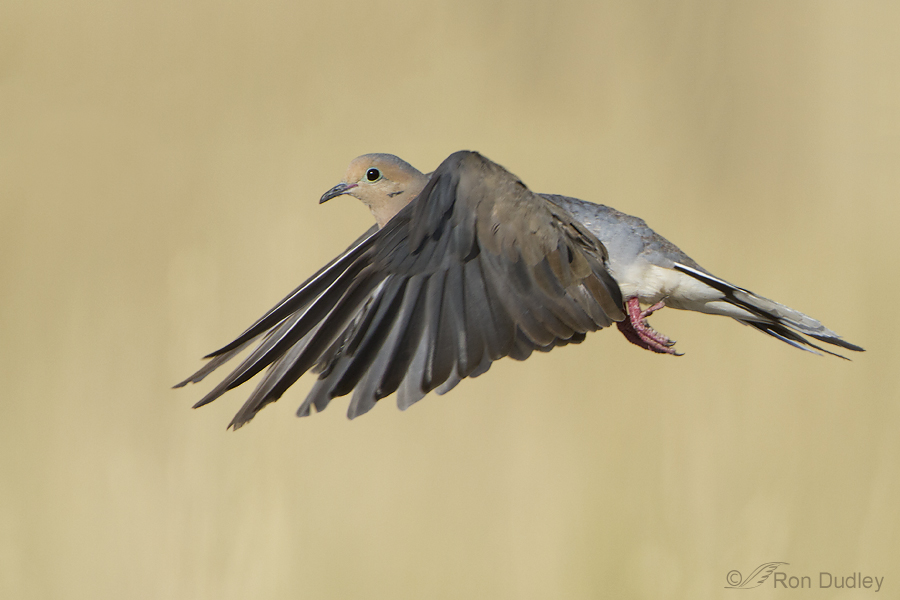Mourning Doves are:
-
habitat generalists, usually only avoiding deep forests and wetlands
- extremely abundant with approximately 350 million of them in the U.S. alone
- short-lived with an average adult life span of approximately one year
- the leading game bird in the U.S. – one million hunters harvest in excess of 20 million doves annually. This number is greater than the annual harvest of all other migratory game birds combined
I’ll make one other observation about the Morning Dove – this one relating to photographers. They’re one of the most difficult of all species I’ve ever attempted to photograph in flight. Their flight is fast and erratic and their take-off speed impressive (most observers are aware of the whistling noise made by their incredibly fast wing beats as they take off and land). All this makes for an aggravatingly difficult bird to photograph in flight – whether at take-off or in full flight. Until yesterday morning I still didn’t have a Mourning Dove flight shot.
1/3200, f/6.3, ISO 500, 500 f/4, 1.4 tc, natural light, canvas added for composition
To be perfectly honest I often don’t even attempt static shots of doves unless I find one in a natural setting that appeals to me. When we came across this dove on a large rock on Antelope Island I took a few shots of it perched and then realized I had a background I liked (dried grasses and other vegetation) and enough light to get a high enough shutter speed for this blazingly fast bird in flight. I adjusted my settings for the shutter speed needed and when the dove crouched slightly (a sign it might take off) I aimed in front of and above the bird and hoped for the best. This is what I got when it launched.
The peek-a-boo flight pose might not appeal to everyone but I like it and for me it’s a start. I think I’ll try this more often in the future.
Ron



Very nice, I love to hear them in my yard. This year, however, we have had a lot more eurasian collared doves hanging around. They are larger and less skittish than mourning doves. I understand that they are an introduced species and are gaining in numbers everywhere. I wonder if they will impact the mourning dove population in any way.
Nice shot! I Like all the info too. Thank you.
Wow, Ron, it doesn’t get much better than that! Great work!!!! That is a tough capture for sure!
Melissa, You’re well aware of what’s tough and what isn’t so I really appreciate what you said.
Our Crested Wood Doves/Pigeons whirr at take off as well. And also have an extremely erratic flight.
This is actually a whistle, Elephant’s Child. Here’s a link to the sound – it’s the fourth one down.
http://www.allaboutbirds.org/guide/mourning_dove/sounds
Thank you for the link to the sound. Quite unlike our Crested Wood Doves whirr. Enchanting.
Wow! Amazing capture Ron!
Thanks, Steve.
Ron! What a coup! You’ll be hard pressed to top, or even equal , this shot….BEAUTIFUL! I had no idea their wing down stroke would look like this…Thet’re so skittish and fast, they’re usually just a blur.
Patty, “They’re usually just a blur” perfectly describes my previous flight shots of this species.
Wow! You really nailed it Ron!
Charlotte Norton
Glad you like it, Charlotte.
well done, Ron!!!
Thanks, Lois.
Wow! I love it. I had no idea their lifespan was so short. Thanks again, Ron.
Nor did I, Sharon. I knew it was short but not that short!
Good catch, Ron. As usual, your post contains yet another little nugget of information. Mourning Doves visit my wife’s feeding station daily, but I never realized that whistling sound was their wings and not a vocalization. Kind of embarrassing since my field of research was physical acoustics.
Thanks, Dwynn. Here’s what Cornell Labs has to say about it – “The sound is actually a whistling—air rapidly moving across or around some sort of constriction in the same manner that sounds are produced when blowing a whistle or flute. It’s just that in the dove’s case, it’s the “whistle” mechanism (the wing) that’s moving through the air and not the air moving through the whistle.” They really don’t know the function of the whistling – they’ve made some guesses but apparently that’s all they are, just guesses.